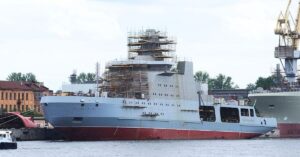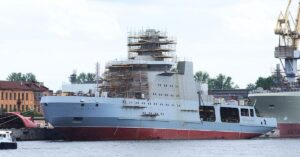
Houthis Claim Missile Attack On 4 Ships Linked To US, UK & Israel
July 2, 2024
IIT Madras Launches World’s First Online MBA In Digital Maritime & Supply Chain
July 3, 2024

Russia is expanding its icebreaker fleet, with its first armed combat icebreaker, Ivan Papanin, now headed for factory sea trials.
The Ivan Papanin, laid down in 2017, is scheduled to join Russia’s Northern Fleet by the end of 2024.
This development is a crucial step in Russia’s preparations for future conflicts in the Arctic region.
The Russian Ministry of Defense has stated that the onboard equipment and propulsion system will be thoroughly tested during these trials.
Ivan Papanin is equipped with a 76mm AK-176MA gun and has pre-installed launchers for anti-ship and Kalibr-NK cruise missiles, which makes it more offensive than the Atomflot’s nuclear icebreakers, which mostly escort commercial vessels through the Northern Sea Route.
With a displacement of approximately 9,000 tons, the vessel can break through five and a half feet of ice, allowing access to most of the Arctic Ocean except during the depths of winter.
The Ivan Papanin is significantly more equipped than Norway’s Svalbard icebreaking patrol vessels, demonstrating Russia’s strategic emphasis on the Arctic.
Two more vessels of this type are being built for Russia’s naval border patrol units.
Russia has commissioned three new nuclear icebreakers in the last four years, with three more under construction.
Ivan Papanin is a member of Russia’s Project 23550 class, designed to perform combat missions with a scalable range of weapons, highlighting the country’s intent to expand armed icebreakers.
Meanwhile, China has also made progress in icebreaker development.
The recent introduction of the Polar Class 6 vessel Ji Di into service increased the number of research icebreakers to three.
Tan Suo San Hao, a larger Polar Class 4 icebreaker, is under construction and is scheduled to begin service in 2025.
In contrast, the United States faces significant delays with its icebreaker program.
Congressional hearings have highlighted ongoing delays and cost overruns. Construction on the new US icebreaker, which will take at least 6-7 years to complete, has yet to begin.
The 50-year-old Polar Star, the US Coast Guard’s sole heavy icebreaker, is undergoing another round of maintenance to extend its service life.
The Polar Star’s current restoration involves a complete revamp of the HVAC system, an electronic control station for the boilers, and a redesign of the flooding alarm system.
This marks the fourth phase of a five-phase service life extension program to keep the vessel operational until a new icebreaker can be built.
TASS says the Russian Navy’s Ivan Papanin has begun factory sea trials.
The ship’s crew has completed extensive training with the Russian Navy and is prepared for Arctic operations.
The Ivan Papanin, launched in October 2019, represents a significant breakthrough in Russia’s Arctic naval capabilities.
It can undertake combat missions and has the potential for future armament upgrades.
The development demonstrates Russia’s strategic commitment to preserving and growing its presence in the increasingly disputed Arctic region.
Reference: The War Zone
Russia’s First Combat Icebreaker, Ivan Papanin, Sets Sail For Sea Trials appeared first on Marine Insight – The Maritime Industry Guide
Source: Maritime Shipping News


